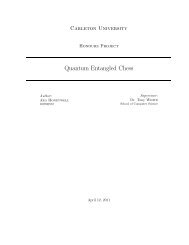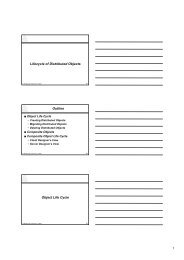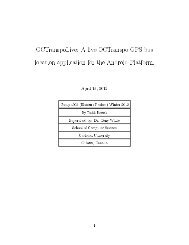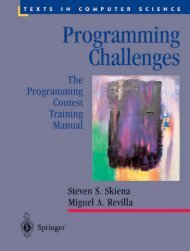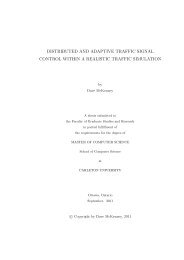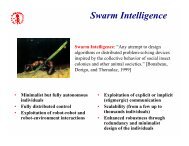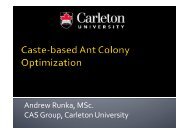Gayan Abeysundara - Complex Adaptive Systems Group
Gayan Abeysundara - Complex Adaptive Systems Group
Gayan Abeysundara - Complex Adaptive Systems Group
Create successful ePaper yourself
Turn your PDF publications into a flip-book with our unique Google optimized e-Paper software.
Dynamic Cellular Channel Allocation using Intelligent Agents April 2005COMP 4905 Honours Projectaverage call lasting 180 seconds may be handed off three times, given the maximum speed. Thismay seem fast, but could represent a realistic situation such as a car on a highway.3.3.1 Random Agent SweepAs noted above, the algorithm that sweeps through ants for cells in high demand was not random.This caused the differing response thresholds between ants in the beginning of the list and ants atthe end of the list. Not only was this sweep algorithm fully randomized, but an extra feature wasadded. Before random stimulations took place, ants located in the neighboring cells werestimulated first. So therefore a cell in high demand initially searched for idle ants that are locatedin its neighboring cells, or even in its own cell. The feature was added because the sweepalgorithm may find an idle ant located five or more cells away, while there could be an idle antlocated right next to the demanding cell, producing inefficient results from long “In Transit”times. This could also represent a more realistic release of pheromones, where the chemicalsubstance propagates from its originating location. This propagation effect initially reachesnearby insects before being sensed by the rest of the colony. To test the effect of the proximitysweep algorithm, a simulation was conducted for 4000 seconds with 20 ants at a call rate of ten,averaged over ten runs. The Random Hotspot call model was used (explained later) because itallowed for a greater variety of possible ant locations, resulting in higher ant-to-cell distances.The results are shown in Table 2.Total Calls Stolen Channels Calls BlockedRandom Sweep 11398 7506 15.2%Proximity Sweep 11413 10444 12.8%TABLE 2. Comparing agent sweep algorithms.The algorithm with the proximity sweep blocked fewer calls. However it resulted in morechannels to be stolen. This is because in the regular random sweep, when a cell successfullystimulates a far off ant, the ant must take some time to travel to the high demand cell. Once thecell has been reached the ant maybe too late to help or the channel usage may have droppedbelow the threshold (65%) and the ant continues to be idle. On the other hand, the sweepalgorithm with the proximity feature allows cells to stimulate nearby ants to steal channels. Thenearby ant can quickly steal channels for the cell in need, resulting in higher channel shufflingrates.13



